The 2019 AEE World Energy Conference and Expo was held September 25-27 at the Walter E. Washington Convention Center in Washington D.C. The event featured 14+ tracks, 56 sessions, over 260 individual speakers, and 62 exhibitors. Both Chiller & Cooling Best Practices and Compressed Air Best PracticesÒ Magazines were pleased to be in the literature bins at the 2019 AEE World!
THE EXPO
Smardt Chillers
My first stop at the Expo was the Smardt booth. Smardt, a well-known leader in the industry is proud to have been making oil-free centrifugal chillers since 2002. On display at the booth was the 115TR air-cooled Smardt chiller with a free cooling package, able to achieve 100% free cooling capacity at 534 GPM, 84/66 and ambient air temperature from 52.5 °F to 37.5 °F. Adding a Smardt free cooling package can drive air-cooled chiller efficiencies to spectacular levels with appropriately low ambient temperatures. Group Marketing Manager, Cam Whitelaw, spoke with me about the innovative free cooling package at length. Cam shared with me that, “In free cooling mode, only the chiller’s condenser fans operate, reaching an unprecedented efficiency as high as .10 kW/TR.”
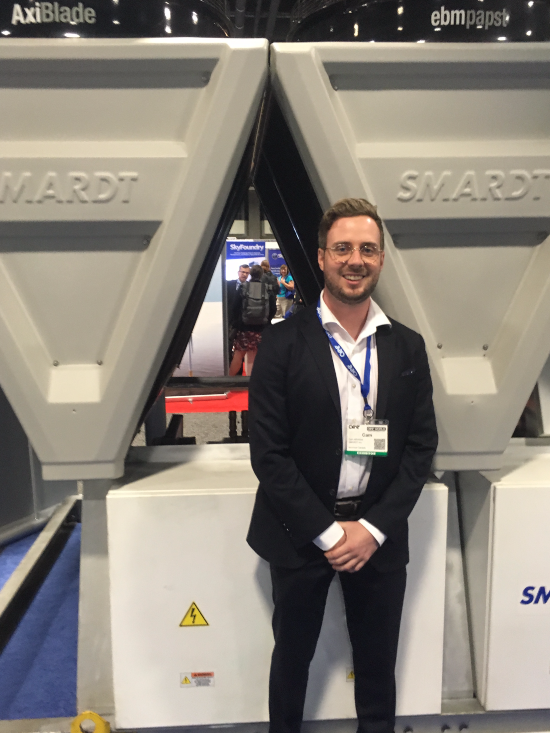
Cam Whitelaw, Smardt Group Marketing Manager, next to the 115TR air-cooled centrifugal Smardt chiller.
Multistack
Another booth I visited was Multistack Chillers, where I met up with Regional Sales Manager, Mike Clatworthy. On display at the booth was Multistack’s Dedicated Heat Recovery Chiller (DHRC). According to Mike, “The heat recovery concept has been around since the 1970’s but was difficult to implement early on. Now, thanks to the modular nature of the DHRC, the implementation of heat recovery is simple because it allows users to control both the flow of hot and cold water simultaneously.” The modular scroll nature of the Multistack DHRC chiller transforms the application of heat recovery from difficult to simple because it provides simultaneous control of hot and cold water. Most buildings have a constant heating and cooling requirement. By identifying the maximum and minimum heating and cooling loads it is easy for customers to size a DHRC from 10 to 900 tons capacity per array. This allows the DHRC to become an integral part of a building’s chiller and boiler systems since the DHRC can produce water at up to 180 °F.
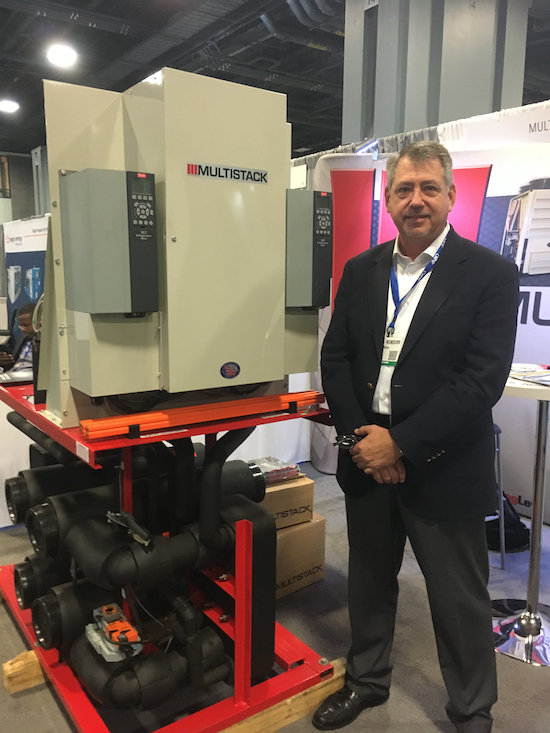
Mike Clatworthy, Multistack Regional Sales Manager, next to the Multistack Dedicated Heat Recovery Chiller.
ElectroCell Systems
ElectroCell Systems has been having their “best year ever,” according to Keith Gonzales, president of BGA Energy. ElectroCell supplies stainless steel, patented, side-stream particle precipitators. These products remove Total Suspended Solids and control Total Dissolved Solids in medium to large HVAC and Process cooling systems. This increases the efficiency of chillers and reduces the risk of bacterial growth, including Legionella.
Thermaxx
Thermaxx is a manufacturer of removable insulation jackets designed to stop thermal waste. Thermaxx Regional Sales Manager Richard Brown said, “Presently our business is growing at a wonderful pace, we have expanded our institutional and medical customer segments throughout 2019.” In a show full of high-tech solutions for addressing energy waste, Thermaxx offers simple, easy to install hot jackets and cold jackets, for steam and chiller piping optimization.
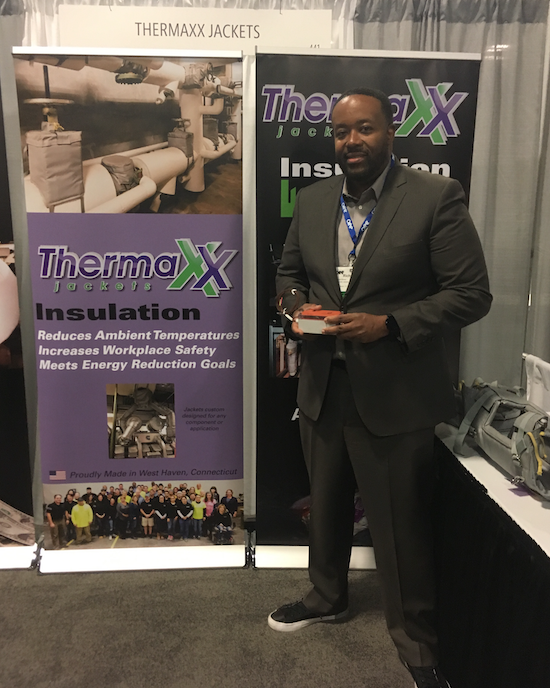
Regional Sales Manager Richard Brown next to the Thermaxx hot and cold piping jackets.
Compressed Air Challenge
The Compressed Air Challenge (CAC) was again present at this year’s AEE Energy Conference and Expo. The CAC is a non-profit organization dedicated to helping compressed air users realize the benefits of improving the performance of their compressed air systems. Joe Ghislan, one of the volunteers with the CAC told me, “In the U.S. a staggering \$1.5 Billion is annually spent on the operation of compressed air systems.” That leaves plenty of space for system optimization! Frank Moskowitz, another of the volunteers manning the CAC booth also volunteered, “Optimizing your compressed air system often results in 20 to 50 % improvements in a given system’s energy efficiency.”
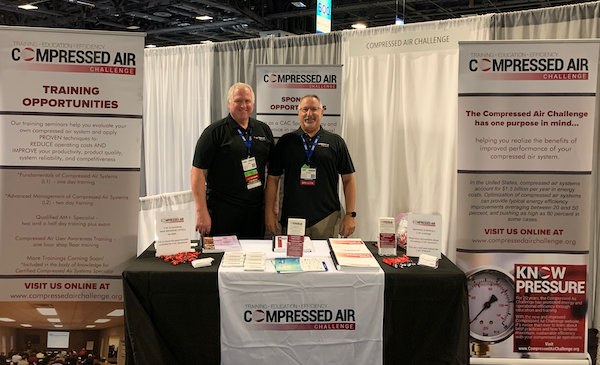
Joe Ghislain and Frank Moskowitz at the Compressed Air Challenge booth (left to right).
Compressed Air Management Technologies
Compressed Air Management Technologies (CAM) was in attendance this year. I learned the booming economy has resulted in a lot of business with past customers who have open new facilities. One particular CAM product in demand is CAMLink Online, a web-based compressed air optimization system. This flexible and secure system allows users to download system data at any time. Additionally, users have the option to set up remote system controls, for complete management of a compressed air system outside of the utility room. Working together with several major compressed air houses, CAM is looking forward to continued growth in 2020.

Jeff Kahn, President, and Chris Wells, Director of Business Development, of Compressed Air Management Technologies (left to right).
Micronics
At the Micronics booth I met with David Casper, Micronics North American Representative. David showed me the company’s wide range of Liquid Flow Meters and BTU meters, key measurement tools for system optimization projects. Both inexpensive and non-invasive, Micronics flow meters can attain an accuracy within a range of 1-3%.
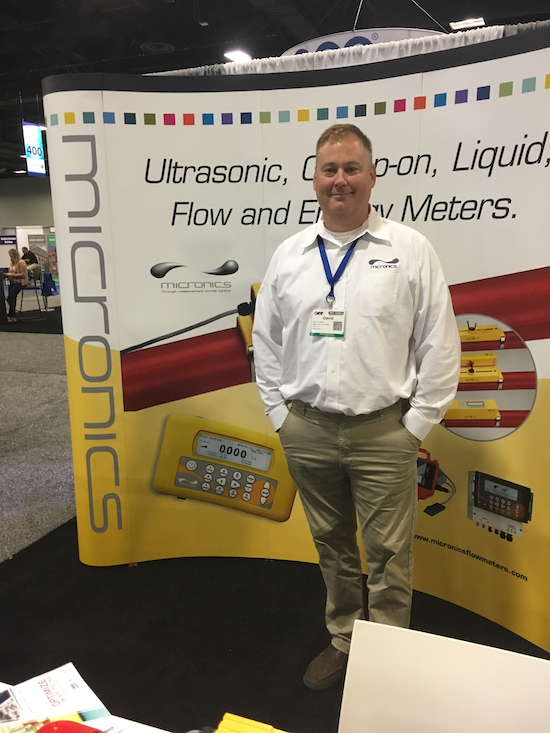
David Casper, North American Representative for Micronics, with the Portaflow 330 portable clamp-on flow meter pictured in the background.
CONFERENCE SESSIONS
Our publications chaired two different two-hour conference sessions, with four speakers each, as part of the AEE World Conference. Below is a snapshot of what was discussed.
Session on “Best Practices in Compressed Air”
Albert Williams, an independent Energy Engineer, presented “Nine Areas of Compressed Air Systems Optimization: Opportunities Based on International Case Studies.” A very interesting fellow who made the long trip from Pretoria, South Africa, he offered an insightful presentation on areas of opportunity, including leakages, artificial demand, and distribution piping irregularities.
Wayne Perry, Senior Technical Director at Kaeser Compressors, presented “Best Practices in Compressed Air Heat Recovery.” This was a very succinct session addressing key questions such as, how can heat be recovered, what can be done with the heat, and where to start the process. Wayne guided attendees through a heat recovery project from start to finish.
Frank Moskowitz, Service Sales Manager at AIRScan, presented “Optimizing Compressed Air Reliability.” His comments offered proven ways to increase reliability and save energy on any compressed air system. Material covered by the presentation included reducing leakage losses, compressor control, network controls, artificial demand, and inappropriate uses of compressed air.
Lou York, Director at Case Controls, presented “Compressed Air Automation for Energy Efficiency and Reliability.” His slides and comments offered a review of control theory and ideas for how automation can both improve reliability as well as improve efficiency.
Session on “Best Practices in Chiller and Cooling Systems”
Quinn Hahs, Project Development Engineer at Flow Energy, presented “Putting Data in Context: How Cooling Coil Performance Data Can Influence Design and Operation.” He provided pointed insight into the use of their SmartValve hardware to optimize coil performance. He explained how stable, precise control of cooling coils can be accomplished. Quinn led his audience on a journey to understand coil performance using data to optimize and improve efficiency.
Devashish Lahiri, Principal at LPI Vidaris, gave an account of his extensive installation work in New York City with a special focus on the optimization of commercial chillers. His presentation was titled, “A field assessment of predicted and actual performance values for Hospitality Installation in New York City.”
Attendees at this session were treated to a perceptive question and answer session, where Devashish was able to leverage his extensive experience to address system optimization questions from facility managers from around the U.S.
Jonathan Kosobucki, Director of Project Development at Optimum, offered his audience a view of his work at the Hershey Medical Center. His presentation was titled, “Chilled Water Optimization and Airside Optimization at Penn State Health, The Milton S. Hershey Medical Center.” This work included installing VFD chiller water pumps, the addition of power monitoring components on all chillers and auxiliary equipment, installing flow meters, temperature sensors, and finally deploying optimization control algorithms.
Ozan Ogus, Senior Project Engineer at Willdan Energy Solutions, reviewed traditional chilled water distribution systems and potential variations. His presentation was titled, How to Realize the Full Potential of Variable Primary Flow Chilled Water Systems.” Outlining the advantages and disadvantages of traditional systems, Ozan’s presentation explored variable primary flow systems in detail. The presentation ended with design and energy considerations for variable primary flow systems and guidelines for evaluating the feasibility of converting traditional systems to a more efficient variable system.
The 2020 AEE World Energy Conference and Expo will be held September 23rd to September 25th at the Colorado Convention Center in Denver. For more information on the 2020 AEE World, visit https://world.aeecenter.org/.
To read more about Chiller and Cooling Technology, visit https://coolingbestpractices.com/technology.
To read more about Compressed Air system optimization, visit www.airbestpractices.com/system-assessments.




